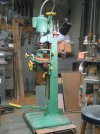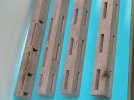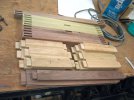My current method of cutting mortises is to use a plunge router with a jig. For the most part, I am pretty happy with this method and can use it with loose tenons that are fit with a planer and rounded over on the router table.
But for some projects I prefer or need a square mortise. I have been toying with the idea of a hollow-chisel mortiser, but shop space is very limited in my one-car garage. So until now I have been cutting/paring these square with bevel-edge chisels. This works ok, but takes a bit of time. I was thinking of trying a mortising chisel or corner chisel so I could pound these out quickly. Has anyone on the forum used either of these tools for this purpose? I heard that corner chisels are very hard to sharpen properly. Mortise chisels would only really work on the exact width of the router-generated slot.
Or, should I just bite the bullet and get a HCM and find some way to shoe-horn it into the shop? Used ones seem to be getting pretty cheap due to the Domino.
Thanks in advance!
But for some projects I prefer or need a square mortise. I have been toying with the idea of a hollow-chisel mortiser, but shop space is very limited in my one-car garage. So until now I have been cutting/paring these square with bevel-edge chisels. This works ok, but takes a bit of time. I was thinking of trying a mortising chisel or corner chisel so I could pound these out quickly. Has anyone on the forum used either of these tools for this purpose? I heard that corner chisels are very hard to sharpen properly. Mortise chisels would only really work on the exact width of the router-generated slot.
Or, should I just bite the bullet and get a HCM and find some way to shoe-horn it into the shop? Used ones seem to be getting pretty cheap due to the Domino.
Thanks in advance!



